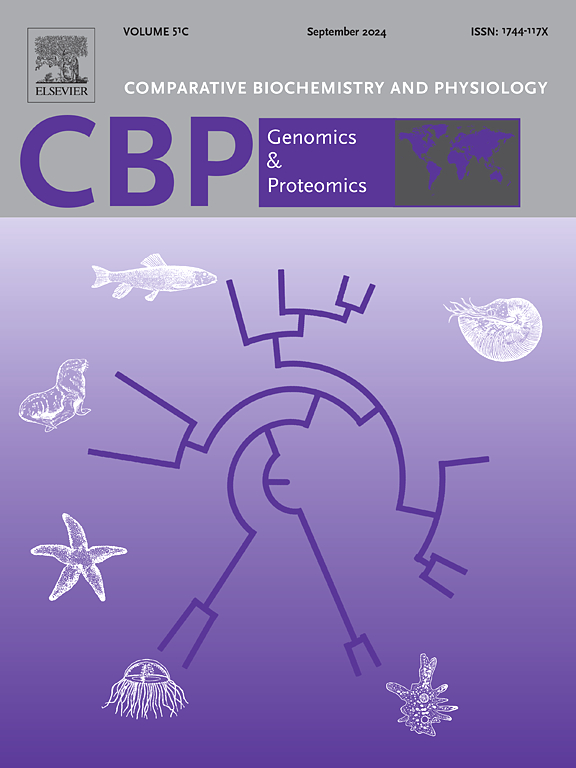Tissue-specific transcriptome analysis in Propsilocerus akamusi provides novel insights into the regulatory mechanisms under deltamethrin exposure
IF 2.2
2区 生物学
Q4 BIOCHEMISTRY & MOLECULAR BIOLOGY
Comparative Biochemistry and Physiology D-Genomics & Proteomics
Pub Date : 2025-05-21
DOI:10.1016/j.cbd.2025.101542
引用次数: 0
Abstract
Deltamethrin is extensively utilized in agricultural pest control and its toxicological impacts on aquatic insects have drawn significant attention. However, the mechanisms of deltamethrin modulates gene expression framework in different tissues remain largely unknown. Herein, we selected non-biting midge, Propsilocerus akamusi (Diptera: Chironomidae), to investigate the gene repertoires in hemolymph, fat body, midgut and Malpighian tubules under the different concentrations of deltamethrin. Distinct tissue-specific gene expression patterns and pH levels were found in the response of P. akamusi to deltamethrin. Deltamethrin induced transcriptional perturbations in cuticle formation-, xenobiotic detoxification-, oxygen transport, and calcium signaling-related genes. The midgut and fat body mainly functioned on oxygen transportation, with the Malpighian tubules engaging in the calcium-ion transmembrane transport, and the overexpression of cuticular protein genes found in the hemolymph. In addition to the key role of detoxification genes, we inferred that deltamethrin perhaps activates calcium signaling pathways that protect against toxins found in the hemolymph and Malpighian tubules. Both organs exhibited upregulation of calcium/calmodulin-dependent protein Kinase II (CaMKII) and voltage-gated calcium channel (VGCC) genes, along with a rise in the pH level. Furthermore, we have compared the tertiary structures of the CaMKII genes in P. akamusi and identified CaMKII members in six other chironomids to explore the characteristics of these species that inhabit adverse environments. Our findings revealed the tissue-specific gene framework for P. akamsui, with particularly high expression detected in the hemolymph, which is instrumental in seeking target organs to develop effective biomarkers for water quality measurement.

赤木拟虫的组织特异性转录组分析为溴氰菊酯暴露下的调控机制提供了新的见解
溴氰菊酯在农业害虫防治中应用广泛,其对水生昆虫的毒理学影响已引起广泛关注。然而,溴氰菊酯调节不同组织中基因表达框架的机制仍不清楚。本实验以不叮蚊赤纹拟蚊(双翅目:手蛾科)为研究对象,研究不同浓度溴氰菊酯处理下赤纹拟蚊血淋巴、脂肪体、中肠和马尔比氏小管的基因库。赤色拟虫对溴氰菊酯的反应具有不同的组织特异性基因表达模式和pH水平。溴氰菊酯诱导角质层形成、外源解毒、氧转运和钙信号相关基因的转录扰动。中肠和脂肪体主要负责氧运输,马尔比管参与钙离子跨膜运输,血淋巴中发现表皮蛋白基因过表达。除了解毒基因的关键作用外,我们推断溴氰菊酯可能激活钙信号通路,保护血液淋巴和马尔比氏小管中的毒素。这两个器官都表现出钙/钙调素依赖性蛋白激酶II (CaMKII)和电压门控钙通道(VGCC)基因的上调,同时pH水平升高。此外,我们还比较了喀斯特拟虫CaMKII基因的三级结构,并在其他六种手拟虫中鉴定了CaMKII成员,以探索这些生活在恶劣环境中的物种的特征。我们的发现揭示了akamsui的组织特异性基因框架,特别是在血淋巴中检测到高表达,这有助于寻找目标器官来开发有效的生物标志物用于水质测量。
本文章由计算机程序翻译,如有差异,请以英文原文为准。
求助全文
约1分钟内获得全文
求助全文
来源期刊
CiteScore
5.10
自引率
3.30%
发文量
69
审稿时长
33 days
期刊介绍:
Comparative Biochemistry & Physiology (CBP) publishes papers in comparative, environmental and evolutionary physiology.
Part D: Genomics and Proteomics (CBPD), focuses on “omics” approaches to physiology, including comparative and functional genomics, metagenomics, transcriptomics, proteomics, metabolomics, and lipidomics. Most studies employ “omics” and/or system biology to test specific hypotheses about molecular and biochemical mechanisms underlying physiological responses to the environment. We encourage papers that address fundamental questions in comparative physiology and biochemistry rather than studies with a focus that is purely technical, methodological or descriptive in nature.

 求助内容:
求助内容: 应助结果提醒方式:
应助结果提醒方式:


